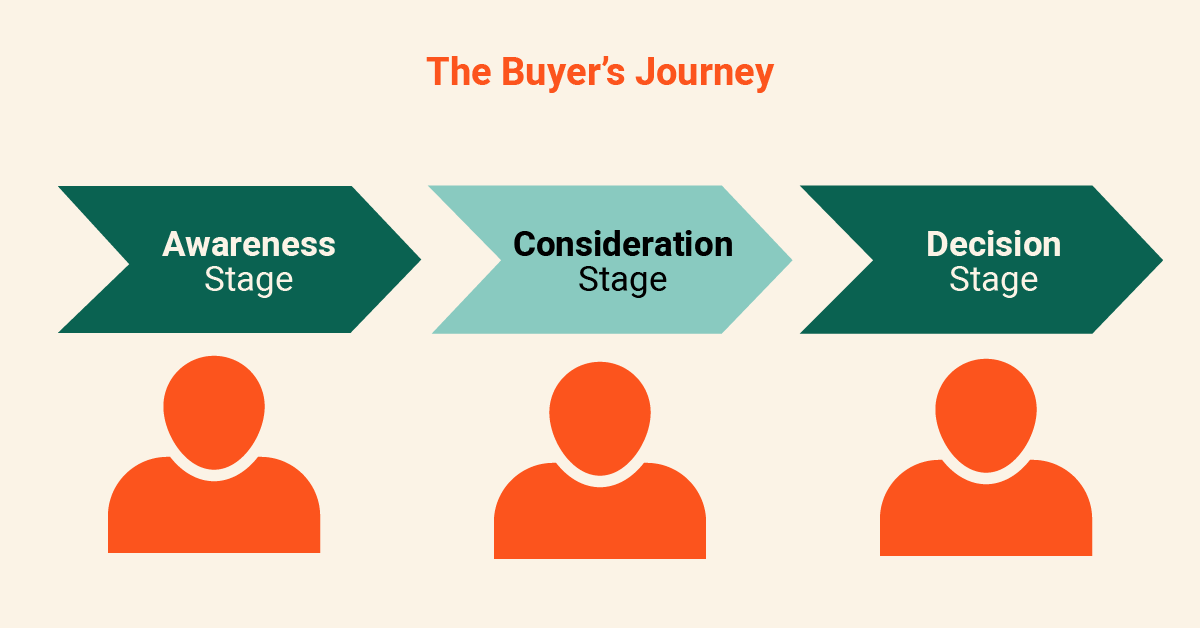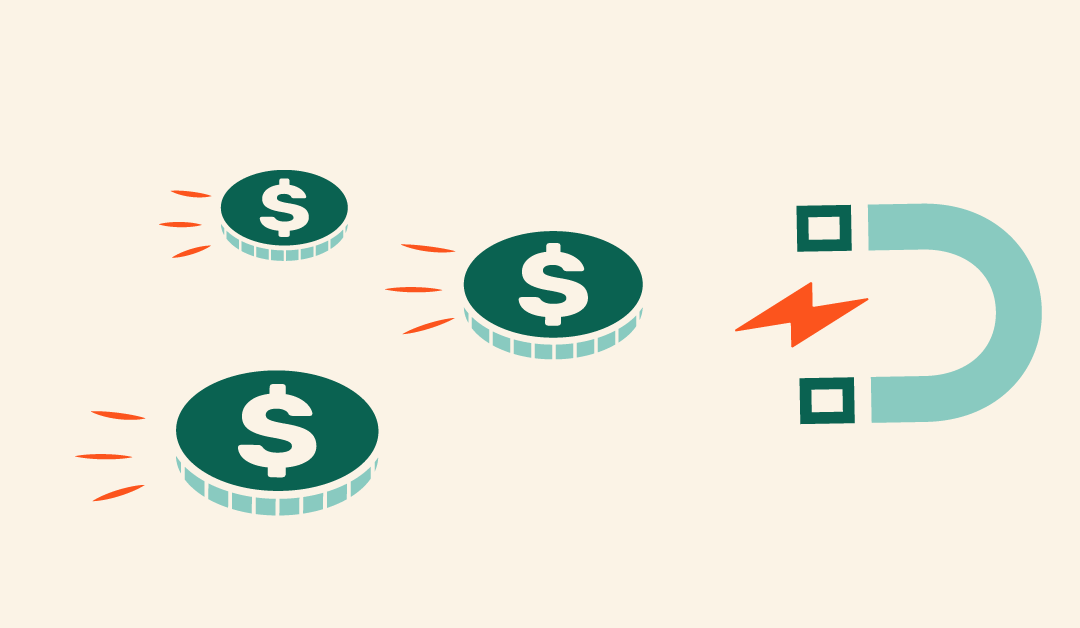If there’s one thing I know about B2B marketers, it’s that the lower their cost per acquisition (CPA), the wider their smile. And I can totally understand why. After all, a lower CPA means greater profit per sale and more sales per budget. What’s not to like about that?
The key to a lower CPA is a shorter funnel. And the key to a shorter funnel is knowing what demand generation tactics to use when. The B2B buying process is a complex beast that often takes up to 6 months (if not longer) for a purchase decision to be made. So timing and targeting your demand generation tactics right is crucial.
How to know what demand generation tactics to use when
Life would be so convenient if all B2B buyers were sitting at the bottom of your marketing funnel just waiting for you to serve up an ad saying ‘buy now’. Since this is just wishful thinking, you’ll instead need to map out the buyer journey for each of your personas. While a considerable simplification of today’s buyer’s journey, HubSpot’s buyer journey model provides a convenient framework for illustrating when different demand generation tactics are most effective.

Demand generation tactics throughout the buyer’s journey
The problem awareness stage
The awareness stage can be broken up into 2 phases. The first is the problem awareness phase and comprises people who aren’t necessarily aware they have a problem. Demand generation tactics that are particularly effective in this stage help to bring this awareness to your buyers.
To create awareness in this stage it’s critical to create a compelling story that will resonate with your target audience so that they can relate it back to their own experience. Guesswork and assumptions are the enemy here. Focus groups, internal discussions and surveys can help you flesh out your personas, identify what was happening in their world when they figured out they had a problem, and give you concrete insight into the story you should be telling them. We find that surveys are a quick and easy way to get this insight directly from your target audience.
Another tactic that will give you access to your target audience is an online community, a LinkedIn Group for example. An online community that’s been established around a common problem faced by your target audience will create a space for them to talk freely amongst themselves. Observing the conversation will give you great insight. A community also affords you the opportunity to ask your target audience questions, so it really is a great two way channel for you to leverage.
Once you have a deep understanding of the problems your target audience faces and what questions they may have, you need to catch their eye. Any content you publish during the awareness stage of the buyer’s journey should offer light information around a topic. Remember, you’re trying to make them aware of their problem and a solution, not sell it to them. Effective demand generation tactics for content distribution are:
- Blogs
- Educational ebooks
- Webinars with thought leaders
- Competitions
- Educational, persona-based ad campaigns
- Social media posts
The solution awareness stage
The second phase of the awareness stage comprises people who are aware that they have a problem and are now looking for a solution. The perfect tactics to grab the attention of these people are through search engines like Google. This is because Google is the place we all go to solve our lives’ biggest problems and you want to be the company they click on to find that ultimate solution.
There are 2 main tactics to use when people use search engines: Organic Search and Paid Search. To appear in organic search results, you need to have a strong Search Engine Optimisation (SEO) strategy in place. While SEO is incredibly effective, it’s a long-term solution and takes patience. A faster way to appear on search engines is through paid search. You can see results from this almost immediately, but these ads don’t hold as much weight with buyers as organic search results.
No matter whether you’re using organic search or paid search, the intention should be the same: give buyers insight into their problem and how they can fix it. If you establish yourself as the go-to resource for your target audience you’ll attract them consistently.
It’s also important to understand how your target audience is engaging with your content during this stage. Some content will naturally resonate more strongly with your audience and understanding what works (or doesn’t work) will help you improve your content overall. Analytics and Conversion Rate Optimisation (CRO) are useful tactics to analyse and understand your audience’s behaviour on your website.
Since your aim is to speed up how buyers move through your funnel, take their visit to your website as an opportunity to get them into your environment for future communication. Tactics like downloadable content, webinars and free tools are great to collect buyers’ email addresses, but don’t forget more subtle tactics such as retargeting pixels. The pages your buyers visit tell you a lot about what products or services they’re interested in. Retargeting pixels make it possible for you to advertise the right products and services to move them down your funnel even faster.
The solution consideration stage
When buyers understand that they have a problem and that solutions are available, they enter the solution consideration stage. It’s during this stage that they start looking for trustworthy providers with the ability to implement their solution. Your goal during this stage is to get the buyer in a room or on a call with your sales team, so at this point your sales pitch can get a bit more forceful.
Demand generation tactics that can help you get into a conversation with specific buyers are retargeting ads, account-based content and social selling. Use these tactics to talk about your solution and the problem it solves. Ideal types of content include comparisons, industry insights, case studies and, of course, information on your actual solution.
While a stronger sales pitch is required, social proof is the secret that will tip the scale in your favour. Buyers always trust the opinion of someone else in their position more than the word of the company trying to sell to them. Be sure to include testimonials and case studies in your content distribution plan. Another excellent tactic is to include existing customers and clients in your community. This will create an environment where prospects can interact with happy customers.
Types of content that can help move buyers from this stage to the next are:
- White papers
- eBooks
- Infographics
- Videos
- Webinars
- Case Studies
- Email Journeys
- Strategy-focused blogs
- Strategy-focuses ad campaigns
- Retargeting ad campaigns
The vendor decision stage
You’re almost there, your buyers have almost signed on the dotted line. In the vendor decision stage, the buying group within your target account is fully aware of their problem and understands what solution they need to implement. All you need to do is convince them as a group that you are the best vendor to choose. Why should they choose you instead of one of your competitors. How will your information align and facilitate their collective decision-making process. The sole purpose of your demand generation tactics in this stage is to tip the scale in your favour. Strong content includes:
- Product comparisons
- Live demos
- Compelling sales decks
- ‘How-it-works’ showcase articles
- Persona-based sales enablement content
- Clear pricing information
Put these demand generation tactics to the test
We have had great success with using these demand generation tactics to help nurture buyers and move them closer to purchase. But success only comes with testing. No two audiences are alike and what works for one brand may not work for another. The final tactic I’d like to include is Conversion Rate Optimisation. Don’t take success for granted, there’s always a better way to do something and that’s where testing your assumptions comes in.
Book a free consultation with one of our demand generation strategists to help more your buyers through your funnel and lower your cost per acquisition.
